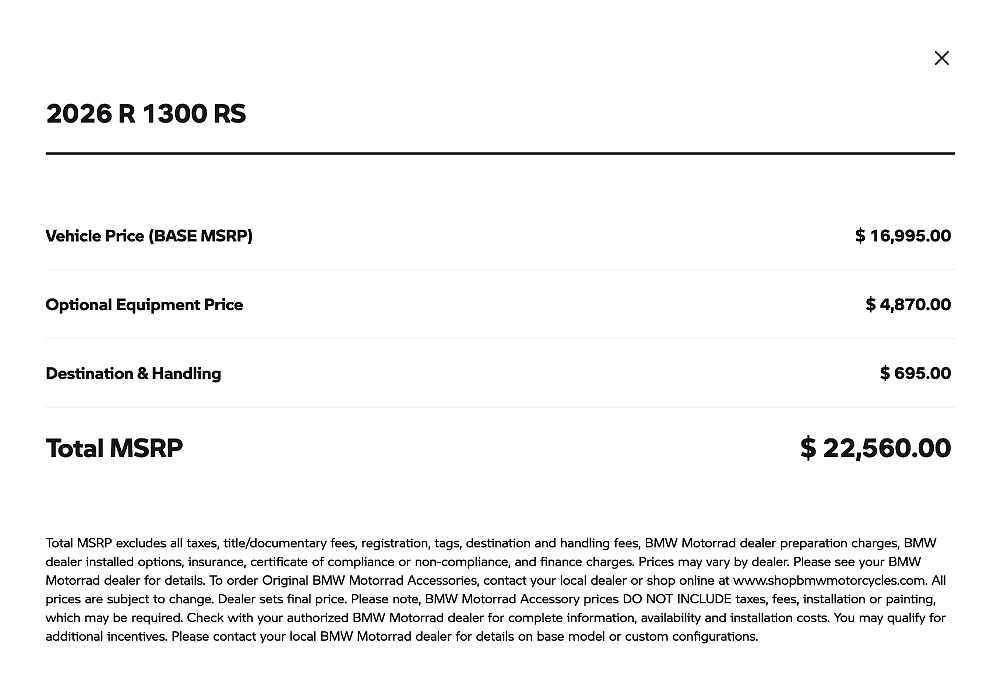BMW completed its 1,300 cc boxer-driven lineup by introducing the 2026 R 1300 RS and R 1300 RT.
Joining the R 1300 GS adventurer and R 1300 R roadster, the tourers bring two flavors of road-oriented travel to the range. The RT sides with a classic touring approach while the RS sprinkles some sporty ingredients into the recipe. The family ties run deep, too, with both models sharing componentry among each other and their other R 1300 relatives.

It runs in the family
The same air/liquid-cooled 1,300 cc opposed twin that underlies the GS and R variants returns to power the RS and RT. BMW still lists the ShiftCam-equipped mill at 145 horsepower (at 7,750 rpm) and 110 foot-pounds of torque (at 6,500 rpm), which accounts for a nine-horsepower and five-foot-pound increase over the outgoing R 1250 models. Like all R 1300s, the RS and RT shoehorn that big boxer into a steel sheet metal frame. From there, the two models take their separate paths.

The RS sticks to the trail blazed by the R 1300 R. That means a 47 mm inverted fork and BMW’s EVO Paralever II suspend the sport-tourer, retaining the same wheel travel (5.5 inches fore and 5.1 inches aft) as its fairing-less sibling. It doesn’t follow in every footstep, though, as the RS’s 28-degree rake helps extend the wheelbase (60.0 inches) to suit long-distance journeys. What wasn’t changed to serve pavement-pounding ventures is the 4.5-gallon tank retained from the R model.

By contrast, the RT shares some qualities with the GS, but street-focused changes give it an identity all its own. For instance, BMW’s front EVO Telelever and rear EVO Paralever return on the RT, but wheel travel shrinks to 5.9 inches and 6.2 inches, respectively. The 17-inch wheelset caters to the model’s road bias while the 6.3-gallon tank extends the periods between fill-ups.

Aside from their differences, the RS and RT come standard with Engine Drag Torque Control (MSR), cornering ABS Pro, Dynamic Traction Control (DTC), and all-around LED lighting. Optional accessories include Ride Modes Pro, BMW’s radar-aided Riding Assistant (with adaptive cruise and front collision warning), Automatic Shift Assist (ASA), electronically controlled Dynamic Suspension Adjustment (DSA), luggage options, and the new center stand Prop-up feature. It’s quite a list. One that BMW is more than happy to dip into.
Nickel and dime
The Munich manufacturer almost always showcases its top-of-the-line trims. For proof, look no further than the promo videos for the R 1300 RS (above) and R 1300 RT (below). Both flaunt the premium-spec version of each model. That can be somewhat misleading, especially when the brand only announces the bike’s starting price.
BMW lists the base model R 1300 RS at $16,995. Good luck getting it anywhere near that price, though. When configuring the bike on BMW’s website, the Racer Blue Package comes out to $22,560 while the Triple Black Package bumps the total up to $23,370. Here’s the kicker. Those are the most affordable options. Outfitted in the Performance Package, the RS sells for $24,560. The Option 719 trim only goes one step further, pushing the price to $24,845. That’s a $7,850 markup. In other words, 46% of the model’s starting price.

It’s a similar story with the R 1300 RT. The costs of the Alpine White ($30,535), Triple Black ($32,575), Impulse ($33,225), and Option 719 ($36,320) Packages all dwarf the tourer’s $22,495 starting price. It’s worth noting that most (if not all) U.S.-bound RSs and RTs will arrive with one of BMW’s accessory packages. Customers can expect those units to appear in dealership showrooms by Q3 or Q4 of 2025.
| 2026 BMW R 1300 RS | 2026 BMW R 1300 RT | |
|---|---|---|
| Price (MSRP) | $16,995 (base before packages) | $22,495 (base before packages) |
| Engine | 1,300 cc, air/liquid-cooled, eight-valve, flat twin | |
|
Transmission, final drive |
Six-speed, shaft | |
| Claimed horsepower | 145 @ 7,750 rpm | |
| Claimed torque | 110 foot-pounds @ 6,500 rpm | |
| Frame | Steel, sheet metal shell | |
| Front suspension | 47 mm inverted fork; 5.5 inches of travel | BMW EVO Telelever; 5.9 inches of travel |
| Rear suspension | BMW EVO Paralever II; 5.1 inches of travel | BMW EVO Paralever, electronically adjustable for spring preload and rebound damping; 6.2 inches of travel |
| Front brake | Dual four-piston radial calipers, 310 mm discs with ABS | |
| Rear brake | Two-piston floating caliper, 285 mm disc with ABS | |
| Rake, trail | 28.0 degrees, 4.8 inches | 26/0 degrees, 4.5 inches |
| Wheelbase | 60.0 inches | 59.0 inches |
| Seat height | 31.1 / 33.3 inches | 30.7 / 33.9 inches |
| Fuel capacity | 4.5 gallons | 6.3 gallons |
| Tires | 120/70 ZR17 front, 180/55ZR17 rear | 120/70 ZR17 front, 180/55ZR17 rear |
| Claimed weight | 540 pounds | 620 pounds |
| Available | Q3/Q4 2025 | |
| Warranty | 36 months / 36,000 miles | |
| More info | bmwmotorcycles.com | bmwmotorcycles.com |












